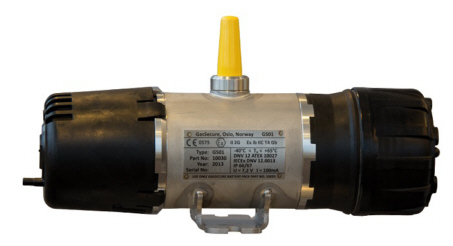|
GasSecure and Yokogawa
Provide SIL2-certified Wireless Gas Detection
System for LNG Facility
 GasSecure AS, a Dräger owned company, and Yokogawa Electric
Corporation announce the delivery of the world’s first SIL2*1 certified wireless gas detection system for use at an LNG facility in
Northern Europe. The two companies will begin promoting the
unique capabilities of this system solution to companies that have a
strong interest in maintaining safe and secure operations. GasSecure AS, a Dräger owned company, and Yokogawa Electric
Corporation announce the delivery of the world’s first SIL2*1 certified wireless gas detection system for use at an LNG facility in
Northern Europe. The two companies will begin promoting the
unique capabilities of this system solution to companies that have a
strong interest in maintaining safe and secure operations.
Background:
Yokogawa has been developing a wide variety of ISA100
Wireless*2 technologies and field wireless devices such as adapters
that enable conventional wired devices to access wireless networks, and
provides them to plants and other facilities primarily in the upstream oil
and
gas sector.
GasSecure has developed ISA100 Wireless gas detectors
that can detect leaks of explosive hydrocarbon*3
gases and are
certified for compliance with the ATEX directive and the IECEx
Certified Equipment Scheme, and installs them on offshore oil and gas
drilling platforms and at tank farms, industrial plants, and the like.
GasSecure has already supplied a number of these products to leading
oil and gas companies around the world.
In 2014, GasSecure and Yokogawa
concluded an agreement under which the two companies jointly developed
a wireless gas detection system that would meet their customers’
requirements.
Overview of the System
This system uses GasSecure’s
GS01 wireless gas detectors to measure hydrocarbon gas concentrations.
Using the ISA100 Wireless communications protocol, the GS01 establishes a
link with a Yokogawa YFGW510 access point and sends data to a host system
via a Yokogawa
YFGW410 field wireless management station. Although the
GS01 uses a low-power infrared sensor and is very energy efficient, it
has a very fast response time. This capability of the GS01 and the
utilization of dual redundant communications by Yokogawa’s field wireless
products make them essential components for the construction of a fast
and highly reliable monitoring solution.
To meet its customers’
safety requirements, GasSecure has made enhancements to the GS01 to
obtain SIL2 certification for this device. For its part, Yokogawa has
modified the YFGW410 so that it now supports the PROFIsafe safety
communication standard, and has verified that
both companies’ products
perform and operate as specified.
Future Direction
In the oil & gas, chemical, and other industries, safety is a paramount
concern at production, storage, and processing sites. Field wireless
systems can be installed in difficult-to-wire locations and have lower
cabling costs than wired systems. For these reasons, field wireless
solutions are ideal for systems that collect production information such
as flow rate, pressure, and temperature. And unlike other wireless
technology platforms, they can be used to construct systems that
perform gas detection and other safety functions, and are well suited
to this purpose. With the release of SIL2-certified wireless gas detection
systems, Yokogawa will actively promote its field wireless equipment
and systems, and will expand this business.
*1 One of the four safety
integrity levels defined in IEC61508, a standard for the functional
safety of electrical and electronic equipment that was developed by the
International Electrotechnical Commission (IEC). SIL2 certification is
generally required for most field safety devices.
*2 A network
protocol based on the ISA100.11a wireless communication standard for
industrial automation that was developed by the International Society of
Automation (ISA), and the applications necessary for its
implementation. This was approved as the IEC62734 international
standard by IEC in October 2014.
*3 A general term for compounds
consisting of carbon and hydrogen, including methane, ethane, benzene,
and toluene. It is the main component of oil and natural gas.
Source:
Marketing Ian Mackay, Knut Sandven
www.@gassecure.com
Related message:
Dräger-Gassecure,
2015 March 11
|
 Worldwide more than Worldwide more than
100,000 paid subscriptions
Since May 2015
Oil, Gas &
Petrochem (OG&PE) is published as part of the
OIL & GAS
JOURNAL to serve a consolidated monthly audience of 135,000 oil/gas professionals worldwide
»
read more |

Worldwide
more than 48,000 subscriptions -
100% one-year direct request
qualification

'What's New' in Upstream, Midstream and
Downstream Products & Services. Circulation 37,000
PennWell
Petroleum Group:
Oil & Gas Journal
Oil & Gas Journal Russia
OGJ_eNewsletter
OGJ-Website-Statistics
Oil, Gas & Petrochem Equipment
Offshore Magazine
Offshore
Russia
Offshore eNewsletter
Offshore
Website Statistics
Oil & Gas Financial Journal
+ + +
For more information, media
kits or
sample copies please contact
Andreas
Sicking
+49 (0)2903-338570
wilhelms@pennwell.com
www.sicking.de
|

 GasSecure AS, a Dräger owned company, and Yokogawa Electric
Corporation announce the delivery of the world’s first SIL2*
GasSecure AS, a Dräger owned company, and Yokogawa Electric
Corporation announce the delivery of the world’s first SIL2*
